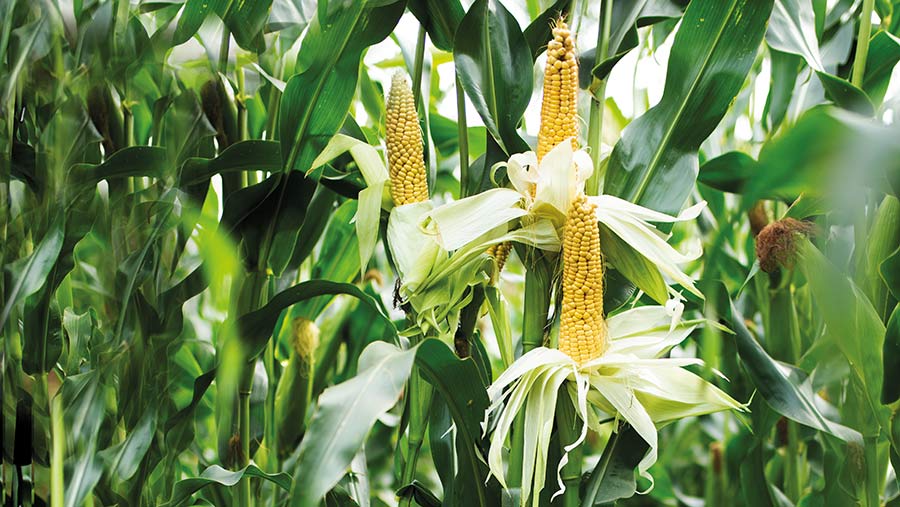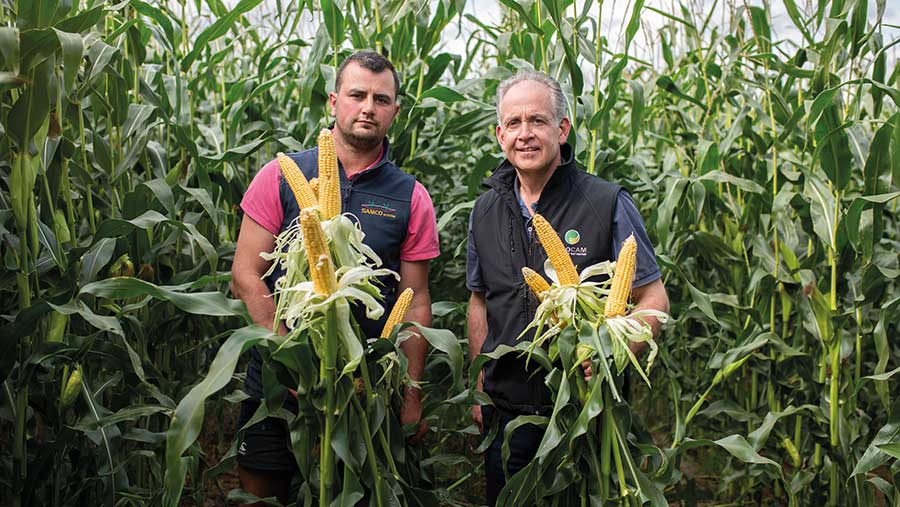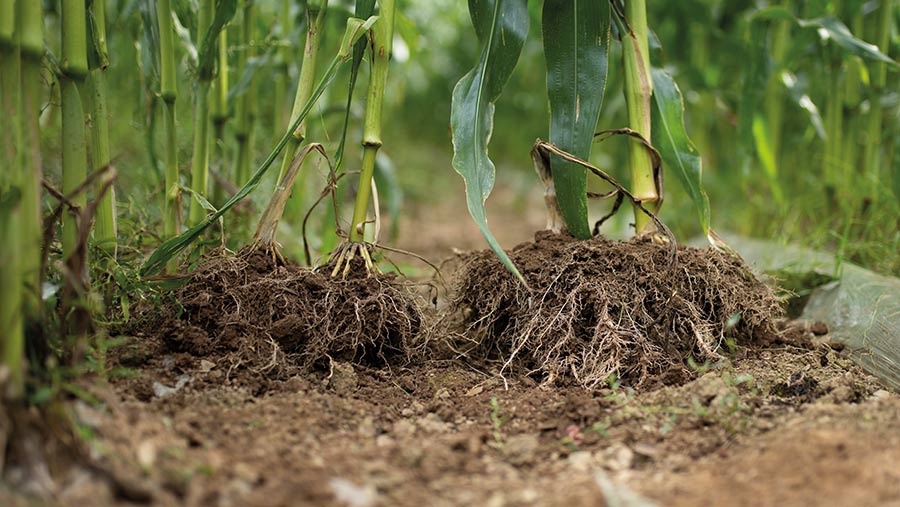How a maize crop hit 57t/ha fresh weight despite drought
 © Mark Jessey
© Mark Jessey Growing maize under film helped a South West dairy farmer achieve yields of 57t/ha freshweight last season, despite being hit by drought.
Patrick Palmer, who grows 202ha (500 acres) of forage-maize to feed his two dairy herds, was impressed that quality was unaffected, with starch averaging 37.7% – up from 28.4% on the previous year, when some maize was still grown conventionally.
See also: 6 top maize growing tips to help livestock producers
Farm facts: Well Park Farm, Buckfastleigh, Devon
- Farms 1,012ha (2,500 acres)
- Housed system
- Milks 1,100 cows across two sites
- Yields 10,000 litres at 4.85% butterfat and 3.75% protein
- Feed rate of 0.31kg/litre of milk
- Milk sold to Saputo
Since opening the clamp to feed the cows and switching from buying in additional, conventionally grown maize to growing maize under film, milk yield has increased by 3 litres a head a day.
Protein content has also lifted, from 3.45% to 3.65%, which is important given he supplies Saputo on a cheese contract.
Maize grown under film is clamped for longer because it is harvested earlier, so this will have helped boost quality, he admits.
Mr Palmer farms in partnership with his dad, Tony, his uncle, Fred, and cousin Paul at Well Park Farm, in Buckfastleigh, Devon.
Last season, they increased the amount of forage maize grown, from 121ha (300 acres) to 202ha (500 acres). The aim was to maximise milk from forage and reduce bought-in feed requirements.
Crop management
With the farm located near Dartmoor, maize performance can be variable, so they have been using film on marginal sites for 15 years. But a trial two years ago convinced them to go the whole hog.
In the trial, the forage lab on the harvester recorded a 20% improvement in the yield of maize grown under film compared with that on conventional sites.
Two varieties were grown in 2022 – Isanto, a robust, earlier-maturing variety was planted on marginal land at the start of April, and P8201, a later-maturing but higher-yielding variety, was sown on better ground in May.
Muck or slurry was applied before the ground was ploughed and disced or power- harrowed. A Samco maize drill was then used.
This drills the seed at a depth of 3.5cm and applies a pre-emergence spray and biodegradable film at the same time.
Harvest
Harvest took place at the end of September, with yields averaging 57t/ha fresh weight at 37.7% starch.
“The grass silage was down so much that the maize has saved us. In total, we were down 15% on the year because third cut grass [taken in the second week of August] yielded so poorly,” says Mr Palmer.
Benefits of using film
- An early maize variety requires 2,200 Ontario heat units to mature. Film provides 300 extra units of heat, allowing later, higher-yielding varieties to be harvested early
- Early varieties can be harvested two to three weeks earlier than those grown in the open. This means winter cereals can be planted after harvest to reduce the risk of soil erosion
- Crop dry matter is improved – for example, from 30% to 34%
- A 0.5 increase in metabolisable energy is possible
- With conventional maize, starter fertiliser containing phosphate is applied at establishment to overcome lower soil temperatures, which would otherwise reduce phosphate availability and plant vigour
- Under film, soil temperatures are improved by 10C, which means maize can be grown using soil reserves of phosphate. These are more readily available at higher temperatures
Source: Barry Mills

Patrick Palmer (left) and Barry MIlls © Mark Jessey
Drought tolerance
The crop had reached about 1.5m in height (50% of its total growth) before the drought hit at the end of June, which is why it was able to withstand the challenging climate.
The Samco system provides ideal growing conditions as it has more heat units. In fact, the soil temperature is warmed by an additional 10C, which improves phosphate availability, explains Barry Mills, ProCam agronomist and adviser for Mr Palmer.
“Because of the accumulation in heat, you get much faster plant development,” he adds.
The main benefit of the system is that it allows earlier planting and faster root growth – five times better than conventionally grown maize – before the main growing period.
“This sets the plant up to be able to absorb more nutrients, with moisture being drawn up from the lower soil profile,” explains Mr Mills.
The moisture improvement is two-fold. “It rains every day under film because you get condensation. For years, we have been using film to overcome marginal growing situations, but we are seeing the benefits of drought tolerance.
“This is the main reason countries like France [use it] in places without irrigation,” explains Mr Mills.

Maize roots © Mark Jessey
Environmental benefits
Harvesting maize earlier in the season allows time for cover crops to be grown over the winter to protect the soil and reduce run-off.
Typically, the Palmers run a rotation of three- to four-year grass leys, followed by barley or wheat for one year and then maize.
On back-to-back maize ground, they sow a winter crop of mustard and oats. This is then grazed by sheep the following March.
Last year, they trialled drilling maize directly into autumn-sown grass in the first week of May, following a first silage cut, but Mr Palmer says they will not be doing it again.
“The drought didn’t help, but we were late cutting grass and that delayed us getting the maize in.” Instead, they believe the mustard and oats work better for them.
Costs and return
The Palmers have recently applied to Countryside Stewardship, which offers a payment of £129/ha for planting a winter cover crop (SW6). This will help pay for the film.
“It is not a cheap crop to grow, but the return on investment is unreal. I don’t think you get a better product for milk constituents,” he says.
Growing 202ha (500 acres) costs the family about £60,000 in film alone annually.
However, Mr Palmer says the return on investment works out at roughly 190%. This is based on a 0.2% improvement in protein delivering an additional £177,400 (an extra 0.01 of protein paying £8,870, multiplied by 20).
“With the fertiliser price where it is, it makes sense to be using film because you get a better-quality crop,” he says.
Advice on growing maize under film
- It does not suit every farm. It requires a lot more attention to detail (crop nutrition, for example)
- Select varieties carefully – some hybrids do not like the extra heat
- Controlling weeds is more difficult because you are relying on pre-emergence herbicides. It is critical to achieve a fine seed-bed l At the eight-leaf stage, the film can be split, and a post-emergence herbicide can be applied, but this adds extra cost
- Do not scrimp on film – choose a good-quality product that can withstand weather conditions on exposed sites
Source: Barry Mills and Patrick Palmer
